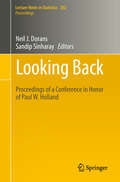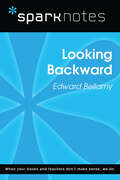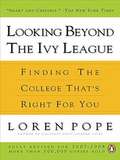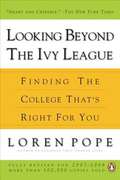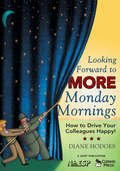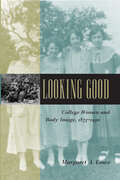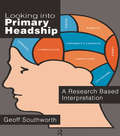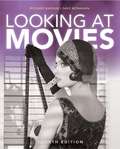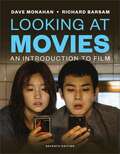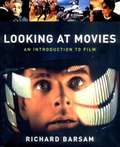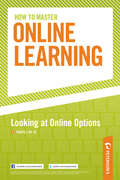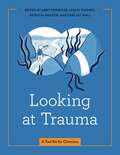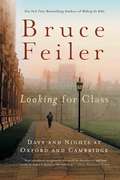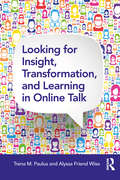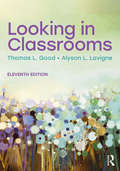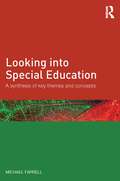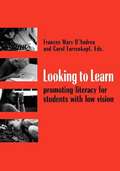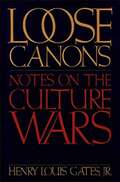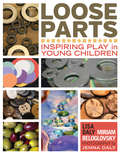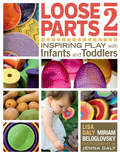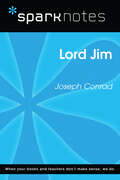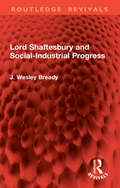- Table View
- List View
Looking Back
by Neil J. Dorans Sandip SinharayIn 2006, Paul W. Holland retired from Educational Testing Service (ETS) after a career spanning five decades. In 2008, ETS sponsored a conference, Looking Back, honoring his contributions to applied and theoretical psychometrics and statistics. Looking Back attracted a large audience that came to pay homage to Paul Holland and to hear presentations by colleagues who worked with him in special ways over those 40+ years. This book contains papers based on these presentations, as well as vignettes provided by Paul Holland before each section. The papers in this book attest to how Paul Holland's pioneering ideas influenced and continue to influence several fields such as social networks, causal inference, item response theory, equating, and DIF. He applied statistical thinking to a broad range of ETS activities in test development, statistical analysis, test security, and operations. The original papers contained in this book provide historical context for Paul Holland's work alongside commentary on some of his major contributions by noteworthy statisticians working today.
Looking Backward (SparkNotes Literature Guide Series)
by SparkNotesLooking Backward (SparkNotes Literature Guide) by Edward Bellamy Making the reading experience fun! Created by Harvard students for students everywhere, SparkNotes is a new breed of study guide: smarter, better, faster. Geared to what today's students need to know, SparkNotes provides: *Chapter-by-chapter analysis *Explanations of key themes, motifs, and symbols *A review quiz and essay topicsLively and accessible, these guides are perfect for late-night studying and writing papers
Looking Beyond the Ivy League
by Loren PopeThe celebrated book that revolutionized the way Americans choose colleges-now fully revised and updated An invaluable guide with virtually no competition, this book helped to establish Loren Pope as one of the nation's most respected experts on the college application process. Now fully revised and updated, Looking Beyond the Ivy League offers a step-by-step guide to selecting the right institution, a checklist of specific questions to ask when visiting a college, the secrets to creating good applications and good applicants, and much more. With as few as one-third of college students remaining at the institution they entered as freshmen, finding the right college is harder than ever before. This book makes it easier for students and their parents. .
Looking Beyond the Ivy League: Finding the College That's Right for You
by Loren PopeThe celebrated book that revolutionized the way Americans choose colleges--now fully revised and updated. Looking Beyond the Ivy League offers a step-by-step guide to selecting the right institution, a checklist of specific questions to ask when visiting a college, the secrets to creating good applications and good applicants, and much more. With as few as one-third of college students remaining at the institution they entered as freshmen, finding the right college is harder than ever before. This book makes it easier for students and their parents.
Looking Forward to MORE Monday Mornings: How to Drive Your Colleagues Happy!
by Diane HodgesPresents low-cost and morale-boosting ideas for group and individual recognition, new year starters, fun activities throughout the year, year-end treats, staff meetings, celebrations, holidays, and winter break.
Looking Good: College Women and Body Image, 1875-1930 (Gender Relations in the American Experience)
by Margaret A. LoweWinner of the Bridgewater State College Class of 1950 Distinguished Faculty Research Award Toward the end of the nineteenth century, as young women began entering college in greater numbers than ever before, physicians and social critics charged that campus life posed grave hazards to the female constitution and women's reproductive health. "A girl could study and learn," Dr. Edward Clarke warned in his widely read 1873 book Sex in Education, "but she could not do all this and retain uninjured health, and a future secure from neuralgia, uterine disease, hysteria, and other derangements of the nervous system." For half a century, ideas such as Dr. Clarke's framed the debate over a woman's place in higher education almost exclusively in terms of her body and her health.For historian Margaret A. Lowe, this obsession offers one of the clearest expressions of the social and cultural meanings given to the female body between 1875 and 1930. At the same time, the "college girl" was a novelty that tested new ideas about feminine beauty, sexuality, and athleticism. In Looking Good, Lowe examines the ways in which college women at three quite different institutions—Cornell University, Smith College, and Spelman College—regarded their own bodies in this period. Contrasting white and black students, single-sex and coeducational schools, secular and religious environments, and Northern and Southern attitudes, Lowe draws on student diaries, letters, and publications; institutional records; and accounts in the popular press to examine the process by which new, twentieth-century ideals of the female body took hold in America.
Looking Into Primary Headship: A Research Based Interpretation
by Geoff SouthworthThis is both a study of leadership and a research methods text. It offers an analytical description of a primary headteacher at work over the course of one school year. Using a mix of participant-observation and interviews, the book provides a portrait of this head's approach to his work - his background, beliefs, the school as a context, what he did, how he dealt with change and development, power and the personal dimension of headship. The portrait is matched to the contemporary literature and an hypothesis is formulated about primary headship and is then used to critique existing ideas about school leadership. The book also suggests ways of developing heads and school teachers.
Looking at Early Years Education and Care
by Linda Miller Rose Drury Robin CampbellFirst published in 2000. Routledge is an imprint of Taylor & Francis, an informa company.
Looking at Movies: An Introduction to Film
by Richard Barsam Dave MonahanLooking at Movies is the most effective introduction to film analysis available. From its very first chapter, Looking at Movies provides students with the tools they need to become perceptive viewers of film. The Fourth Edition is not only more comprehensive, but also more accessible and sophisticated in its integration of media.
Looking at Movies: An Introduction to Film
by Richard Barsam Dave MonahanStudents love watching movies. Give them the tools to understand why. <p><p>Building on students’ enthusiasm for screened entertainment, Looking at Movies is more successful than any other text at motivating students to understand and analyze what they see onscreen. The Seventh Edition features new and refreshed video, assessment, and interactive media, making the book’s pathbreaking media program more assignable and gradable than ever before. Looking at Movies gives instructors all they need to inspire students to graduate from passive watching to active looking.
Looking at Movies: An Introduction to Film
by Richard BarsamIn using the work "looking" in the title of his introductory college-level film text, Barsam (emeritus, film studies, Hunter College) hopes to demonstrate that students need to actively examine relationships of form and content in cinema. Primarily focused on introducing film analysis, the text does include some discussion of film history, theory, and production.
Looking at Online Options
by Peterson'sThis eBook is Part I from Peterson's How to Master Online Learning which provides the most comprehensive information about online degree programs, online certifications, and continuing education; advice on paying for online classes, software, and textbooks; and expert strategies for online learning success.
Looking at Trauma: A Tool Kit for Clinicians (Graphic Medicine #23)
by Abby Hershler, Lesley Hughes, Patricia Nguyen, Shelley WallLooking at Trauma: A Tool Kit for Clinicians is an easy-to-use, engaging resource designed to address the challenges health care professionals face in providing much-needed trauma psychoeducation to clients with histories of childhood trauma. Developed by trauma therapists Abby Hershler and Lesley Hughes in collaboration with artist Patricia Nguyen and biomedical communications specialist Shelley Wall, this book presents twelve trauma treatment models accompanied by innovative and engaging comics. The models help clinicians provide practical information about the impacts of trauma to their clients—and support those clients in understanding and managing their distressing symptoms.Topics covered include complex posttraumatic stress disorder, emotion regulation, memory, relationship patterns, and self-care. Each chapter features step-by-step instructions on how to use the treatment models with clients; practical educational tips from experienced clinicians in the field of childhood trauma; interactive trauma education comics; a foundational framework focused on care for the provider; and references for further study.Intended for use in therapeutic, clinical, and classroom settings, this book is a valuable resource for all healthcare workers. In particular, social workers, psychotherapists, spiritual care providers, nurses, occupational therapists, psychologists, primary care physicians, and psychiatrists will find this tool kit indispensable.
Looking at Trauma: A Tool Kit for Clinicians (Graphic Medicine)
by Abby Hershler, Lesley Hughes, Patricia Nguyen, Shelley WallLooking at Trauma: A Tool Kit for Clinicians is an easy-to-use, engaging resource designed to address the challenges health care professionals face in providing much-needed trauma psychoeducation to clients with histories of childhood trauma. Developed by trauma therapists Abby Hershler and Lesley Hughes in collaboration with artist Patricia Nguyen and biomedical communications specialist Shelley Wall, this book presents twelve trauma treatment models accompanied by innovative and engaging comics. The models help clinicians provide practical information about the impacts of trauma to their clients—and support those clients in understanding and managing their distressing symptoms.Topics covered include complex posttraumatic stress disorder, emotion regulation, memory, relationship patterns, and self-care. Each chapter features step-by-step instructions on how to use the treatment models with clients; practical educational tips from experienced clinicians in the field of childhood trauma; interactive trauma education comics; a foundational framework focused on care for the provider; and references for further study.Intended for use in therapeutic, clinical, and classroom settings, this book is a valuable resource for all healthcare workers. In particular, social workers, psychotherapists, spiritual care providers, nurses, occupational therapists, psychologists, primary care physicians, and psychiatrists will find this tool kit indispensable.
Looking for Class
by Bruce FeilerAn irresistible, entertaining peek into the privileged realm of Wordsworth and Wodehouse, Chelsea Clinton and Hugh Grant, Looking for Class offers a hilarious account of one man's year at Oxford and Cambridge -- the garden parties and formal balls, the high-minded debates and drinking Olympics. From rowing in an exclusive regatta to learning lessons in love from a Rhodes Scholar, Bruce Feiler's enlightening, eye-popping adventure will forever change your view of the British upper class, a world romanticized but rarely seen.
Looking for Insight, Transformation, and Learning in Online Talk
by Trena M. Paulus Alyssa Friend WiseLooking for Insight, Transformation, and Learning in Online Talk is a comprehensive guide to analyzing digital interaction in formal and informal online spaces. The book establishes a new research framework for addressing major challenges that have arisen as social exchanges, meaning-making, and knowledge-building increasingly take place in social media, discussion forums, and online communities. With a focus on methodological alignment to support valid and trustworthy knowledge claims, the authors present a series of design decisions to help researchers: frame their object of interest and unpack underlying assumptions understand key differences between researcher-influenced and pre-existing online talk ethically extract and organize data for analysis apply rigorous qualitative, quantitative, and computational methods to answer their research questions Written for scholars in education, business, communication, media studies, health sciences, political sciences, and beyond, this is a thorough approach to the research methods and concerns essential to the study of talk in online contexts.
Looking in Classrooms (Eleventh Edition)
by Thomas L. Good Alyson L. Lavigne<p>Looking in Classrooms uses educational, psychological, and social science theories and classroom-based research to teach future classroom teachers about the complexities and demands of classroom instruction. While maintaining the core approach of the first ten editions, the book has been thoroughly revised and updated with new research-based content on teacher evaluation, self-assessment, and decision-making; special emphases on teaching students from diverse ethnic, cultural, class, and gender-identity contexts; and rich suggestions for integrating technology into classroom instruction. <p>Widely considered to be the most comprehensive and authoritative source available on effective, successful teaching, Looking in Classrooms synthesizes the knowledge base on student motivation, classroom management, teacher expectations, teacher effectiveness, adaptive instruction for individual learners, and informative observational techniques for enhancing teaching. It addresses key topics in classroom instruction in an accessible fashion, promoting easy intepretation and transfer to practice, and articulates the roles of teacher-centered pedagogy, student-centered instruction, and project-based learning in today‘s classroom. <p>Guided by durable historical knowledge as well as dynamic, emerging conceptions of teaching, this text is ideal for undergraduate teacher training programs and for masters-level courses for teachers, administrators, and superintendents.</p>
Looking into Special Education: A synthesis of key themes and concepts
by Michael FarrellContemporary and stimulating, Looking into Special Education provides an engaging overview of the key areas of special education, with each chapter providing valuable insight into the nature and practice of special education today. Aiding understanding and acting as a framework for further study, thought and practice, this innovative new book concerns a wide range of disabilities and disorders and is international in scope. Chapters discuss: The historical dimensions of special education How to engage with the structural frameworks (legal and definitional issues) of special education today The philosophical foundations of special education, including positivism Criticisms of special education and a consideration of future trends The fundamentals of evidence-based practice and how professional judgement is used The benefits of multi-professional collaboration Organisational issues of mainstreaming and special schooling. Including further reading material and ‘concluding thinking points’ at the end of each thought-provoking chapter, Looking into Special Education will be of particular use to professionals and students of special education and related fields looking to enrich their understanding and practice.
Looking to Learn: Promoting Literacy for Students with Low Vision
by Frances Mary D'Andrea Carol FarrenkopfThis handbook provides teachers with practical tips and advice on improving literacy skills for students with low vision with easy-to-understand explanations of vital topics such as interpreting eye reports, performing functional vision assessments, and working with low vision service providers along with chapters on games and activities that teachers can use in their classrooms.
Loose Canons: Notes on the Culture Wars
by Henry Louis GatesMulticulturalism. It has been the subject of cover stories in Time and Newsweek , as well as numerous articles in newspapers and magazines around America. It has sparked heated jeremiads by George Will, Dinesh D'Sousa, and Roger Kimball. It moved William F. Buckley to rail against Stanley Fish and Catherine Stimpson on "Firing Line." It is arguably the most hotly debated topic in America today--and justly so. For whether one speaks of tensions between Hasidim and African-Americans in Crown Heights, or violent mass protests against Moscow in ethnic republics such as Armenia, or outright war between Serbs and Croats in Yugoslavia, it is clear that the clash of cultures is a worldwide problem, deeply felt, passionately expressed, always on the verge of violent explosion. <p><p>Problems of this magnitude inevitably frame the discussion of "multiculturalism" and "cultural diversity" in the American classroom as well. In Loose Canons , one of America's leading literary and cultural critics, Henry Louis Gates, Jr., offers a broad, illuminating look at this highly contentious issue. Gates agrees that our world is deeply divided by nationalism, racism, and sexism, and argues that the only way to transcend these divisions--to forge a civic culture that respects both differences and similarities--is through education that respects both the diversity and commonalities of human culture. His is a plea for cultural and intercultural understanding. (You can't understand the world, he observes, if you exclude 90 percent of the world's cultural heritage.) <p><p>We feel his ideas most strongly voiced in the concluding essay in the volume, "Trading on the Margin." Avoiding the stridency of both the Right and the Left, Gates concludes that the society we have made simply won't survive without the values of tolerance, and cultural tolerance comes to nothing without cultural understanding. Henry Louis Gates is one of the most visible and outspoken figures on the academic scene, the subject of a cover story in The New York Times Sunday Magazine and a major profile in The Boston Globe , and a much sought-after commentator. And as one of America's foremost advocates of African-American Studies (he is head of the department at Harvard), he has reflected upon the varied meanings of multiculturalism throughout his professional career, long before it became a national controversy. <p><p>What we find in these pages, then, is the fruit of years of reflection on culture, racism, and the "American identity," and a deep commitment to broadening the literary and cultural horizons of all Americans.
Loose Parts
by Miriam Beloglovsky Lisa Daly Jenna DalyUse loose parts to spark children's creativity and innovationLoose parts are natural or synthetic found, bought, or upcycled materials that children can move, manipulate, control, and change within their play. Alluring and captivating, they capture children's curiosity, give free reign to their imagination, and motivate learning.The hundreds of inspiring photographs showcase an array of loose parts in real early childhood settings. And the overviews of concepts children can learn when using loose parts provide the foundation for incorporating loose parts into your teaching to enhance play and empower children. The possibilities are truly endless.
Loose Parts 2: Inspiring Play with Infants and Toddlers
by Janet Gonzalez-Mena Miriam Beloglovsky Lisa DalyLoose parts capture children's curiosity, give free reign to their imagination, and encourage creativity. This form of play allows infants to be in control and recognize the power of their bodies and actions. A variety of new and innovative loose parts ideas are paired with beautiful photography to inspire safe loose parts play in your infant and toddler environments. Captivating classroom stories and proven science provide the context for how this style of play supports children's development and learning. This book is perect for Montessori and Reggio-inspired programs and educators.
Looseleaf For How To Design And Evaluate Research In Education
by Norman Wallen Helen Hyun Jack FraenkelHow to Design and Evaluate Research in Education is directed to students taking their first course in educational research. Because this field continues to grow so rapidly with regard to both the knowledge it contains and the methodologies it employs, the authors of any introductory text are forced to carefully define their goals as a first step in deciding what to include in their book. In our case, we continually kept three main goals in mind. We wanted to produce a text that would: <P><P> 1. Provide students with the basic information needed to understand the research process, from idea formulation through data analysis and interpretation. <br>2. Enable students to use this knowledge to design their own research investigation on a topic of personal interest. <br>3. Permit students to read and understand the literature of educational research.
Lord Jim (SparkNotes Literature Guide Series)
by SparkNotesLord Jim (SparkNotes Literature Guide) by Joseph Conrad Making the reading experience fun! Created by Harvard students for students everywhere, SparkNotes is a new breed of study guide: smarter, better, faster. Geared to what today's students need to know, SparkNotes provides: *Chapter-by-chapter analysis *Explanations of key themes, motifs, and symbols *A review quiz and essay topicsLively and accessible, these guides are perfect for late-night studying and writing papers
Lord Shaftesbury and Social-Industrial Progress (Routledge Revivals)
by J. Wesley BreadyOriginally published in 1926, this volume is much more than a biography of an outstanding politician, social reformer and philosopher. It provides an analysis of the history of social conditions in England during the nineteenth century, as well as a discussion of the development of social affairs and the inertia of political psychology. The role that faith and religion played in motivating Lord Shaftesbury’s desire for social reform is also discussed as is the ways in which he and John Wesley transformed the social and ethical ideas of England to enshrine in law many of the working conditions that we take for granted today such as defined hours of work and rest periods.
